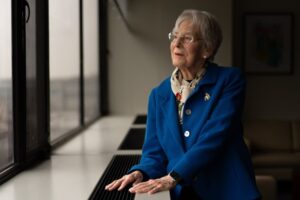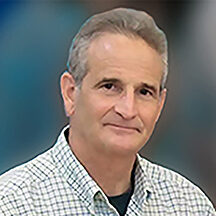$1 Billion Surprise
One of the wondrous highlights of American philanthropy is that every year we are overwhelmed by spectacular gifts from men and women about whom we really haven’t heard much. The latest example is an awesome $1 billion gift from Dr. Ruth Gottesman, Ed.D., Chair of the Einstein Board of Trustees and Montefiore Health System board member, benefiting the Albert Einstein College of Medicine in New York City. This historic gift — the largest made to any medical school in the country — will ensure that no student at Einstein will have to pay tuition again. This transformational gift is intended to attract a talented and diverse pool of individuals who may not otherwise have the means to pursue a medical education. It will enable generations of healthcare leaders who will advance the boundaries of research and care to be free from the burden of crushing loan indebtedness. With this donation, all current fourth-year students will be reimbursed their spring 2024 semester tuition and, effective beginning in August of this year, all students moving forward will receive free tuition. Albert Einstein College of Medicine was founded in 1955 with a mission to welcome all students, without restrictions. This gift furthers that mission by removing the financial restrictions for those without the economic means to afford medical school. Dr. Gottesman joined Einstein’s Children’s Evaluation and Rehabilitation Center (CERC) in 1968. At a time when learning problems were often unrecognized and misdiagnosed, she developed widely used screening, evaluation, and treatment modalities that have helped tens of thousands of children. In 1992, she started the Adult Literacy Program at CERC, the first of its kind, which is still in operation. In 1998, she was named the founding director of the Emily Fisher Landau Center for the Treatment of Learning Disabilities (at CERC). Dr. Gottesman earned her bachelor’s degree at Barnard College and her master’s and doctoral degrees from Teachers College, Columbia University. She is Clinical Professor Emerita of Pediatrics (Developmental Medicine) at Einstein. Over the course of her 55-year association with the College of Medicine, Dr. Gottesman’s dedication and philanthropic vision have helped make Einstein the remarkable institution it is today. She and her late husband, David S. Gottesman, have been enormously generous donors in the past to Einstein’s innovative research and education initiatives.
Most Generous
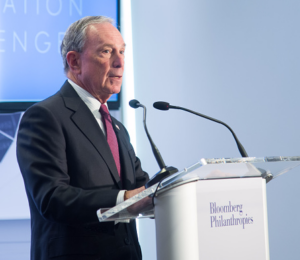
Other mega philanthropists came as no surprise. Michael Bloomberg, the former New York City mayor, gave the most to charitable causes last year, followed by Nike co-founder Phil Knight and his wife, Penny, and Michael Dell and his wife, Susan, according to the Chronicle of Philanthropy’s exclusive list of the 50 Americans who donated the largest sums to non-profits last year. Bloomberg contributed $3 billion to support the arts, education, environment, public health, and programs aimed at improving city governments around the world, while the Knights gave $1.24 billion, including support for the University of Oregon and an ambitious poverty-fighting effort in Portland, Oregon. The Dells contributed nearly $976 million to their charitable funds, which distribute gifts to a wide array of charities. For the first time, Bill Gates and Melinda French Gates appear separately on the list — she at No. 9 and he at No. 16. And all three co-founders of Home Depot are on the list — Bernie Marcus at No. 10, Ken Langone at No. 12, and Arthur Blank at No. 21. Together, the 50 donors on the list contributed a total of $11.9 billion to charity in 2023. The median amount they gave was $100 million. While those numbers are sizable, not all of the nation’s wealthiest people appear on the list. Only 23 of the richest Americans on the Forbes 400 list donated enough to appear on the Philanthropy rankings.
Meet in the Middle

Only a few individuals have the capacity to make leadership gifts, that’s why at a time when it’s appearing more challenging to attract and retain donors, there’s robust evidence of finding promise in the middle. A new Sea Change Strategies report finds that 31% of mid-level donors have made a bequest and 23% are considering it. Midlevel donors, who give $1,000 to $10,000 annually, are extremely loyal. While they’re unlikely to move into the ranks of leadership donors, they are good prospects for giving within that range and help organizations through lean times. The report surveyed 5,900 midlevel donors across 36 organizations, exploring their key traits and what motivates them. It finds that 53% of midlevel donors have been giving to the charity they support for 10 years or more. These donors also tend to be older; the lion’s share are either baby boomers (61%) or members of the silent generation (21%). Only 13% are Generation X, and 5% are millennials and Gen Z. Fifty-nine percent of the donors identified as women, while 39% identified as men, and 3% chose not to answer. The survey finds most midlevel donors connected with their favorite causes when they were young; 72% engaged with their cause by the age of 39. The bulk of those people (42%) connected at age 20 to 39, while a smaller share (19%) connected in their teens, and the remainder (11%) found their cause at age 12 or younger.
The Ultra-Wealthy
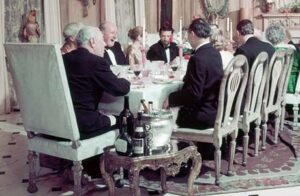
Altrata’s latest report provides a unique and detailed view of wealthy donor activity. It focuses on the world’s ultra-high net worth (UHNW) population, people with a net worth of $30 million or more. The ultra wealthy gave a total of $190 billion to philanthropic causes in 2022, almost 25% more than in 2018. These individuals, who each have a net worth of $30 million or more, account for a prominent and growing share of all individual giving, at almost 38%. Focusing even higher up the wealth chain, the world’s 3,200 billionaires accounted for 8% of all individual giving. There are significant gains to be made by organizations that can tailor their prospecting and engagement strategies to this demographic.
- The ultra wealthy in North America were the source of almost half of all global UHNW donations, giving a total sum of $91 billion. This largely reflects the region’s elevated wealth and its longstanding tradition of public giving. Europe’s ultra wealthy gave a third of all UHNW donations in 2022, and the region experienced one of the strongest growth rates in (nominal) annual giving globally, with a 29% rise between 2018 and 2022. UHNW giving in Asia accounted for a modest 13% global share. Although Asia is the world’s second-largest ultra wealth region, its non-profit sector is less developed (but expanding quite rapidly).
- Donors with a very high affinity for philanthropic giving — defined as the top 20% of UHNW donors, who have donated the highest proportion of their total wealth since 2018 — are different. We find that wealthy women are more likely to have a high affinity for giving. Also, there is no clear connection between an UHNW individual’s source of wealth and their charitable generosity, while liquidity is higher among UHNW high-affinity donors, comprising 46% of their wealth holdings on average.
- Aside from sports, the top interests vary considerably among those who give to certain causes. Aviation and technology are among the main passions of UHNW donors who give to educational causes, while travel is of more interest to those who give to the arts and culture. Organizations often need to adopt different approaches to establish a link to the cause they are advocating for — and drawing on wealthy people’s interests and passions can help light that spark or strengthen an emotional connection.
- Almost one in five of all UHNW individuals has a private foundation. This share increases to almost 30% among those with a net worth of over $100 million, underlining the growing number and importance of private charitable foundations. UHNW individuals with private foundations are generally older, have a slightly higher female representation and are more likely to have solely inherited their wealth than the average UHNW individual.
Across the Big Pond

Three-quarters of the UK. public think the charity sector is a force for good but separate it from political activity. Politics does not have a positive reputation in the UK. New data on trust in institutions shows that only 18% of the public trust the government, and 8% trust political parties, according to new data from the Sheila McKechnie Foundation and nfpResearch. Researchers included a mixture of voting intentions in the groups. There were five main conclusions to the data:
- People in the UK don’t aspire to be “political;”
- Warm charity audiences can be convinced of the impact of political work of charities, but aren’t there yet;
- People don’t connect with the language of politics;
- The public is more comfortable with some charity sectors lobbying rather than others; and,
- Charities are not seen as the sector that has power in the UK.
On the subject of comparing and contrasting philanthropy and fundraising in the US and UK, we’re thrilled to present Bernard Ross, Director, =mc consulting, Europe’s leading management and fundraising consultancy, as subject matter expert in our April 3rd webinar. His distinguished 30-year career includes writing eight books on a wide range of issues — from the psychology of influence to the role of decision science on social change. We are hoping that friends across the Big Pond will stay up late to join their colleagues who lead non-profits in the States. You can register for this free webinar here.
Data

Candid is the largest source of data about the demographics of non-profit leaders, board members, and staff. Between July 2019 and December 2023, over 66,000 non-profits reported some data about the race/ethnicity, gender identity, sexual orientation, and/or disability status of their leader, board members, and/or staff via Candid’s non-profit profiles. Here is how this data has evolved over the past five years and what this may mean for the future of the data set:
(1) More non-profits are sharing demographic data each year: The number of distinct organizations sharing demographic data with Candid each year has steadily increased, from 3,273 in 2019 to 40,271 in 2023.
(2) Most organizations have updated their demographic data at least once; just over half (52%) of non-profits that have shared demographic information since 2019 have done so more than once.
(3) Non-profits are sharing more demographic information each year: Among organizations providing any demographic data, the already high proportion sharing data about their leader(s) went up from 77% in 2019 to 90% in 2023. This increase came largely after Candid made sharing demographic information about their leader(s) a minimum requirement for organizations for the Gold Seal of Transparency. The other demographic categories saw slightly more modest, yet promising, increases.
(5) Non-profits are sharing more data for each demographic category (though gaps between categories persist): Among organizations providing any demographic data, the percentage sharing data in each demographic category — race/ethnicity, gender, sexual orientation, and/or disability status — generally increased over the five-year period Overall, non-profits were most likely to share data about female/male/non-binary gender identity followed by race and ethnicity. The categories with the least amount of data were transgender/cisgender identity, sexual orientation, and disability status.
Art Philanthropy

Most contemporary art institutions in the US depend on private funding. The Metropolitan Museum of Art in New York City reported receiving more than $250 million in philanthropic support in 2018, while the Museum of Fine Arts in Boston reported more than $60 million. The majority of art institutions operate on limited budgets. Government grants contribute a modest 15% to art museums’ annual budgets. Northeastern University Center for Complex Network Research used its network science tools to develop a detailed quantitative picture of philanthropic art funding to find the patterns that govern private giving and help art organizations fundraise more efficiently. The researchers found that the number of grants given to an art organization strongly correlated with the prestige of that institution and that almost half of the donors awarded more than 50% of grants in their own state. While art institutions enjoy a high donor retention rate (almost 70% after one year), high localization of philanthropic funding can make organizations compete for donors both within the same art genre and with other genres.
Getting Donors to Respond

One of the most perplexing challenges we face is getting donors to respond after they ignore our phone calls, e-mail, text, social media and other outreaches. The simple truth is that there are no one-size-fits-all easy answers. Over my career coping with this tricky challenge, I’ve organized my thinking into 10 lessons. Our thanks to Bloomerang for featuring our article, Fundraising Basics: What to do when they won’t respond? We hope you find the content of value as you apply it in your day-to-day activities, and it helps prompt return messages.
Celebrity Corner

Actor and entrepreneur Eva Longoria has received $50 million from Amazon founder Jeff Bezos and his fiancée, Lauren Sánchez, to spend on the charitable organizations of her choice. The money is part of Bezos’ annual “Courage & Civility” prize, awarded to individuals who make significant contributions to society. Longoria has been a longtime advocate for Latino communities in the U.S. In 2012, she established the Eva Longoria Foundation to provide educational programs, scholarships, mentorship and entrepreneurship for Latinas. The programs including STEM education for girls, a parent engagement program, microloans and business training, as well as research and advocacy around Latina educational and economic advancement. Longoria is not the only recipient of the award this year. An additional $50 million was awarded to retired Navy four-star Adm. Bill McRaven. A former chancellor of the University of Texas system, McRaven advised Presidents George W. Bush and Barack Obama as well as other U.S. leaders on defense issues. McRaven has focused on supporting veterans and the children of fallen soldiers. Bezos has been giving out these awards to philanthropists since 2021. Previous recipients include chef José Andrés, singer and songwriter Dolly Parton and media personality Van Jones.
On Bookshelf: Sunshine Girl
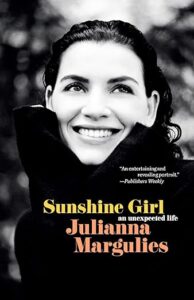
I’ve been madly in love with my wife Andrea for more than three decades, but I must admit that I have a crush on Julianna Margulies during her distinguished career playing an ER nurse, dynamite attorney/politician’s wife to most recently a distinguished TV journalist (not to mention playing a flight attendant in that unforgettable classic, “Snakes on a Plane.”) As an apple-cheeked bubbly child, Julianna was bestowed with the family nickname “Sunshine Girl.” Shuttled back and forth between her divorced parents, often on different continents, she quickly learned how to be of value to her eccentric mother and her absent father. Raised in fairly unconventional ways in various homes in Paris, England, New York and New Hampshire, Julianna found that her role among the surrounding turmoil and uncertainty was to comfort those around her, seeking organization among the disorder, making her way in the world as a young adult and eventually an award-winning actress. Throughout, there were complicated relationships, difficult choices, and overwhelming rejections. But there were also the moments where fate, faith, and talent aligned, leading to the unforgettable roles of a lifetime, both professionally and personally — moments when chaos had finally turned to calm. Filled with intimate stories and revelatory moments, Sunshine Girl is at once unflinchingly honest and perceptive. It is a riveting self-portrait of a woman whose resilience in the face of turmoil will leave readers intrigued and inspired. And now you know who I have a crush on.
Free Pet Care

We’ve always contended that pets do more for us than we do for them. The Schwarzman Animal Medical Center in New York City is one of a handful of veterinary hospitals across the country that is equipped to handle the most complicated cases. One recent patient, Harrison, a French bulldog, is a familiar sight, having previously been cared for by the hospital’s surgery, neurology, internal medicine and dental teams. His owner, Grace Kim, says the coordination of care makes a huge difference. Most patients will pay out of pocket, but AMC also covers some charity care, especially for rescue animals and working dogs. In 2022, the hospital donated $4.4 million in care. We would love to see more veterinary hospitals emulate this type of compassion for our four-legged family members. By the way, shown is a recent photo of our senior cat, Billie, who is a frisky 14-year-old thanks to a lifetime of outstanding care she has received from Alamo Feline Health Center, San Antonio’s only feline-specialty vet clinic.
Quiz: Best Baseball Parks
It’s that time of year again and there’s nothing like a trip to the ballpark to take in a Major League Baseball game — whether you’re a score-keeping fanatic, casual fan or a kid just there for ice cream helmet cups. MLB’s stadiums each have their own unique history, with ballparks ranging in age from over 100 years old (Fenway Park and Wrigley Field) to Texas’ retractable roof stadium that just opened in 2020. With the goal of creating the ultimate MLB stadium rankings, eight baseball reporters and editors from around the USA TODAY Network ranked MLB’s current stadiums 1 to 30, adding up the aggregate scores to determine the order. We fully recognize that these findings will spark debate. Match the following top finishers with their respective ranking (No.1 means the best).
Answers are shown at the bottom of the page.
1. Camden Yards Baltimore (a) 1
2. Fenway Park Boston (b) 2
3. Oracle Park S.F. (c) 3
4. PNC Park Pittsburgh (d) 4
5. Wrigley Field Chicago (e) 5
Stratagems is published monthly by Jim Eskin, Founder of Eskin Fundraising Training, LLC. We offer workshops and customized training sessions for board members, staff and volunteers of non-profit organizations of all kinds and sizes. For details about our services and information, or to find out how to schedule a training session for your organization, visit our website. Follow our events on Facebook, and read more articles about philanthropy on our LinkedIn page.
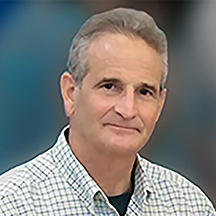
Jim Eskin, Founder
Eskin Fundraising Training
Email: [email protected]
Cell: 210.415.3748
www.eskinfundraisingtraining.com
ANSWERS TO THIS MONTH’S QUIZ: 1=d, 2=e, 3=b, 4=a, 5=c |

